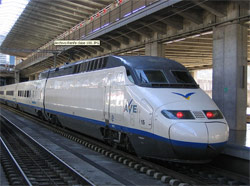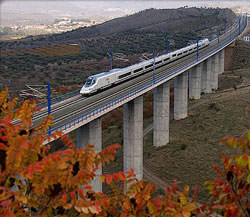|
(28/04/2011)
Given this context the objectives of the Aero-Ave (1) project are To analyze the impact of integration between long distance transport modes (air and high speed railways), and to evaluate how such integration may facilitate improvements in interconnections between long distance modes and urban transport networks.
Currently the project is close to its completion, having concluded the reports 1 and 2. Report 1 gathers a literature review and a revision of the international experience. It contains three main parts, a review of literature concerning published works on the air-rail intermodality issue, a revision of the current intermodality situation at main airports in Europe: Roissy-CDG, Zurich, Copenhague-Kastrup, London-Heathrow, Amsterdam-Schiphol, Bruselas and Lyon-St. Exupéry, and a deep analysis of the most successful experience of air-rail intermodality in Europe: the air-railway supply as provided in Germany from Frankfurt airport.
The AiRail services, that combines services from Deutsche Bahn with the air services from Lufthansa, allows some corridors to complete intermodal trips without any modal breakdown.
Report 2
Report 2 gathers the theoretical models and the identification of barriers and opportunities for the air-rail intermodality. In relation to theoretical models these are based on the fact that high speed railways and planes have been considered ad substitutive modes that compete between them.
However, in spite of competition advantages, it might be possible that integration between planes and high speed railway becomes more beneficial. As a conclusion, we can state that cooperation is beneficial for operators that take part in the integration process, though social benefit of intermodality remains uncertain when there are capacity restrictions (due to competition losses in the market).
At the same time, the social welfare would increase in the case of competition among air carriers (just because of the opposite). Regarding environmental effects, these seem to be positive when there is airport congestion at the airports affected by the integration process, whilst the effects appear as ambiguous when there is competition among air carriers.
Working groups
Two working groups were constituted for the identification of barriers and opportunities for intermodality. Within these groups the elements that customers valued most in the case of air-rail intermodal products were identified.
Elements like total travel time, price, baggage management or the integrated management of booking and boarding passes, were considered as very relevant on the users’ part in order to accept intermodality.
Barriers associated to lack of technological change or to normal practices in the operation of different transport modes were not considered as an insurmountable aspect, being the main problem for the development of intermodality the need to implement cooperation agreements among different agents that would be beneficial for them all. One of the most important elements is the final price that is required to be lower than the sum of prices for each of the trip parts.
Spanish lines
At the moment the case studies of the project are being finalized. These are the following: Madrid-Barcelona, Madrid-Toledo, Airport and HSR Málaga and routes connecting the Canaries with Mainland Spain.
In the Madrid-Barcelona case study it is not only this route what is examined, buy a set of domestic routes with origin in Madrid. By econometric means we evaluate whether the high speed rail have significantly changed the frequency, the number of passengers and the market share of airlines. Our results show that it has reduced on average the number of air transport operations by 17 percent. On the other hand the demand has increased substantially, though the weight of air transport in the total market has been reduced, as it has been reduced the weight of the dominant Spanish air carrier Iberia on air markets.
The case study of Madrid-Toledo analyzes the HSR attraction of users coming from other modes of transport (private vehicle, bus) due to an improvement in intermodality (connection Madrid Center-Madrid Barajas Airport). A stated and revealed preference survey is conducted. For the case of stated preferences the questionnaire is directed to workers who live in Toledo but need to travel through Madrid Barajas for business reasons.
 Málaga airport Málaga airport
In the case study of the Airport and HSR Málaga, the purpose consists of assessing the benefits and costs associated with the strategies of competition and cooperation in an intermodal transport system that combines air and high speed railway transport. In our exercise of evaluation we assess the current situation at the Málaga-Madrid route, this is a situation in which both modes of transport compete, against another theoretical scenario in which we assume that all passengers switch to the high speed railway as result of a strategy of cooperation between air carriers and the high speed railway company.
Finally, in the case study of the routes between the Canary Islands and Mainland Spain, the modal integration between the HSR and the air services in these routes is examined. This case study emphasizes the most relevant attributes for this alternative to be sufficiently attractive for users in order to compete with the current alternative air transport-air transport.
(1) AVE is the acronym of Spanish High Speed (Alta Velocidad Española)
|

